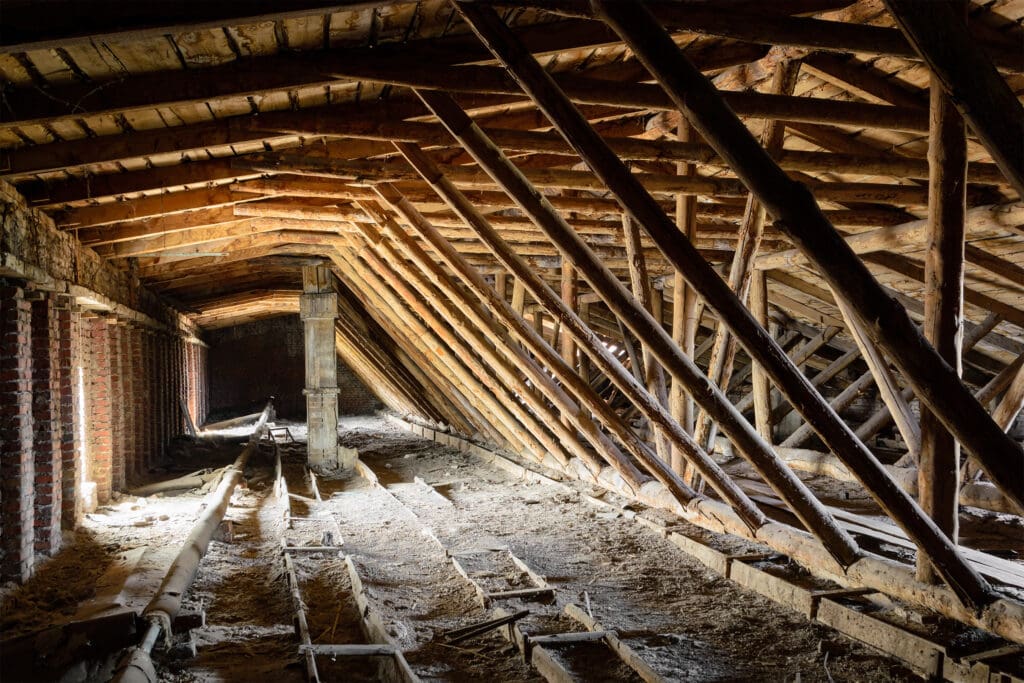
Published on January 12, 2022
Your roof is the first line of defense against the elements of your home, but the attic plays a big role in the overall comfort of your home. While it’s important for the home to be as airtight as possible, your attic needs proper venting to help regulate the temperature and promote air circulation.
A well-insulated attic with an appropriate amount of vents should remain dry all year long for the most part. By keeping the warm air in the house, you won’t have to worry about it mingling with the cooler temperatures in the attic. When warm and cool mix, that’s when problems in your attic space occur.
What causes attic condensation?
Think of a cold glass of water on a summer day. Before too long, little droplets of water begin to appear on the outside of the glass. They drip down and leave a little ring of water on your coffee table. The same thing happens in your attic when the warm air from the home meets the cold insulation or the underside of the roof. When there are moisture issues in the attic, it can do much more damage. The water will eventually seep into the trusses, decking, and insulation.
Is attic condensation bad?
It certainly can be if not addressed. Anytime you have lingering moisture in the home, whether it’s a dripping fixture under the sink or accumulation condensation in the attic, you run the risk of problems. It could cause damage to the structure of your home or even affect the health of you and your family.
Mold and mildew love warm, damp spaces. And even though your attic may not be the warmest part of the house, it’s an ideal environment for these airborne particulates. If left unaddressed, it can continue to grow into the walls of your home and cause a very real health concern. Before too long, the home may be uninhabitable until the mold is mitigated.
How to get rid of attic condensation
Although we all expect our houses to meet local codes and regulations, older homes may not necessarily meet newer specifications. If you are having excessive moisture problems in your attic areas, it could be time to have a professional come out and inspect your roofs.
An inspection can ensure you have the right amount of vents on your roof. As a rule of thumb (although jurisdictional codes may differ), you should have a one-square-foot vent for every 300 square feet of attic floor area. It could just be a matter of adding a few more vents.
Also, check to see if you have soffit vents and make sure they aren’t being blocked. An attic ventilation system allows the outside air to come into the attic and leave through the ridge vents in the roof. By keeping the air circulating, there’s less chance warm moist air from the living spaces will get to mingle with cooler air or surfaces.
How to stop attic condensation
Now that you know how to get rid of attic condensation, how do you keep it from happening in the first place? There are a few steps you can take, but it could take some effort. The least intrusive way to keep condensation from forming in your attic is to place a vapor barrier along the floor of the attic.
This will prevent the water vapor carried by the warmer heat from entering the attic. You may need to lift the existing insulation to place and install the vapor barrier and then put the insulation back in place. No insulation at all in the attic? You’ll definitely need to rectify that by installing insulation with the recommended R-value.
Want to take more active measures? Consider installing an attic dehumidifier. They can be programmed to turn on when humidity levels reach a certain plateau. But you’ll need electricity to power the humidifier and figure out a way to eventually remove the water that’s been taken out of the air.
For other questions about your roofing, or if you’re considering an upgrade or complete tear-off, contact Warner Roofing. We also install solar tubes, skylights, and gutter systems. We look forward to hearing how we can help.